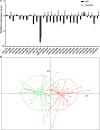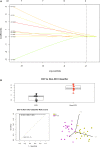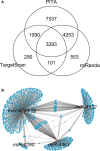Circulating MicroRNAs in Delayed Cerebral Infarction After Aneurysmal Subarachnoid Hemorrhage
- PMID: 28442458
- PMCID: PMC5533026
- DOI: 10.1161/JAHA.116.005363
Circulating MicroRNAs in Delayed Cerebral Infarction After Aneurysmal Subarachnoid Hemorrhage
Abstract
Background: Delayed cerebral infarction (DCI) is a major cause of morbidities after aneurysmal subarachnoid hemorrhage (SAH) and typically starts at day 4 to 7 after initial hemorrhage. MicroRNAs (miRNAs) play an important role in posttranscriptional gene expression control, and distinctive patterns of circulating miRNA changes have been identified for some diseases. We aimed to investigate miRNAs that characterize SAH patients with DCI compared with those without DCI.
Methods and results: Circulating miRNAs were collected on day 7 after SAH in healthy, SAH-free controls (n=20), SAH patients with DCI (n=20), and SAH patients without DCI (n=20). We used the LASSO (least absolute shrinkage and selection operator) method of regression analysis to characterize miRNAs associated with SAH patients with DCI compared with those without DCI. In the 28 dysregulated miRNAs associated with DCI and SAH, we found that a combination of 4 miRNAs (miR-4532, miR-4463, miR-1290, and miR-4793) could differentiate SAH patients with DCI from those without DCI with an area under the curve of 100% (95% CI 1.000-1.000, P<0.001). This 4-miRNA combination could also distinguish SAH patients with or without DCI from healthy controls with areas under the curve of 99.3% (95% CI 0.977-1.000, P<0.001) and 82.0% (95% CI 0.685-0.955, P<0.001), respectively.
Conclusions: We found a 4-miRNA combination that characterized SAH patients with DCI. The findings could guide future mechanistic study to develop therapeutic targets.
Keywords: biomarker; delayed cerebral infarction; miRNA; stroke; subarachnoid hemorrhage.
© 2017 The Authors and SDIVF R&D Centre, National Research Center for ART and Reproductive Genetics. Published on behalf of the American Heart Association, Inc., by Wiley.
Figures





Similar articles
-
Circulating microRNA 132-3p and 324-3p Profiles in Patients after Acute Aneurysmal Subarachnoid Hemorrhage.PLoS One. 2015 Dec 16;10(12):e0144724. doi: 10.1371/journal.pone.0144724. eCollection 2015. PLoS One. 2015. PMID: 26675167 Free PMC article.
-
MicroRNA Changes in Cerebrospinal Fluid After Subarachnoid Hemorrhage.Stroke. 2017 Sep;48(9):2391-2398. doi: 10.1161/STROKEAHA.117.017804. Epub 2017 Aug 2. Stroke. 2017. PMID: 28768799 Free PMC article.
-
The prognostic value of serial leukocyte adhesion molecules in post-aneurysmal subarachnoid hemorrhage.Clin Chim Acta. 2012 Feb 18;413(3-4):411-6. doi: 10.1016/j.cca.2011.10.007. Epub 2011 Nov 3. Clin Chim Acta. 2012. PMID: 22074931
-
Vasospasm after spontaneous angiographically negative subarachnoid hemorrhage.Acta Neurochir (Wien). 2012 Jul;154(7):1127-33. doi: 10.1007/s00701-012-1383-4. Epub 2012 May 16. Acta Neurochir (Wien). 2012. PMID: 22588341 Review.
-
Angiographic vasospasm versus cerebral infarction as outcome measures after aneurysmal subarachnoid hemorrhage.Acta Neurochir Suppl. 2013;115:33-40. doi: 10.1007/978-3-7091-1192-5_8. Acta Neurochir Suppl. 2013. PMID: 22890640 Review.
Cited by
-
The Role of Epigenetics in Brain Aneurysm and Subarachnoid Hemorrhage: A Comprehensive Review.Int J Mol Sci. 2024 Mar 19;25(6):3433. doi: 10.3390/ijms25063433. Int J Mol Sci. 2024. PMID: 38542406 Free PMC article. Review.
-
Roles of miR‑4463 in H2O2‑induced oxidative stress in human umbilical vein endothelial cells.Mol Med Rep. 2017 Sep;16(3):3242-3252. doi: 10.3892/mmr.2017.7001. Epub 2017 Jul 15. Mol Med Rep. 2017. PMID: 28713907 Free PMC article.
-
Extracellular Vesicle-Enriched miRNA-Biomarkers Show Improved Utility for Detecting Alzheimer's Disease Dementia and Medial Temporal Atrophy.J Alzheimers Dis. 2024;99(4):1317-1331. doi: 10.3233/JAD-230572. J Alzheimers Dis. 2024. PMID: 38788066 Free PMC article.
-
microRNA-130b May Induce Cerebral Vasospasm after Subarachnoid Hemorrhage via Modulating Kruppel-like Factor 4.Mol Cell Biol. 2023;43(7):301-316. doi: 10.1080/10985549.2023.2210030. Epub 2023 Jun 29. Mol Cell Biol. 2023. PMID: 37381993 Free PMC article.
-
Development and validation of urinary exosomal microRNA biomarkers for the diagnosis of acute rejection in kidney transplant recipients.Front Immunol. 2023 May 9;14:1190576. doi: 10.3389/fimmu.2023.1190576. eCollection 2023. Front Immunol. 2023. PMID: 37228607 Free PMC article.
References
-
- Al‐Khindi T, Macdonald RL, Schweizer TA. Cognitive and functional outcome after aneurysmal subarachnoid hemorrhage. Stroke. 2010;41:e519–e536. - PubMed
-
- Wong GK, Lam S, Ngai K, Wong A, Mok V, Poon WS; Cognitive Dysfunction after Aneurysmal Subarachnoid Haemorrhage I . Evaluation of cognitive impairment by the montreal cognitive assessment in patients with aneurysmal subarachnoid haemorrhage: prevalence, risk factors and correlations with 3 month outcomes. J Neurol Neurosurg Psychiatry. 2012;83:1112–1117. - PubMed
-
- Wong GK, Poon WS, Boet R, Chan MT, Gin T, Ng SC, Zee BC. Health‐related quality of life after aneurysmal subarachnoid hemorrhage: profile and clinical factors. Neurosurgery. 2011;68:1556–1561; discussion 1561. - PubMed
-
- Scott RB, Eccles F, Molyneux AJ, Kerr RS, Rothwell PM, Carpenter K. Improved cognitive outcomes with endovascular coiling of ruptured intracranial aneurysms: neuropsychological outcomes from the International Subarachnoid Aneurysm Trial (ISAT). Stroke. 2010;41:1743–1747. - PubMed
Publication types
MeSH terms
Substances
LinkOut - more resources
Full Text Sources
Other Literature Sources
Medical

